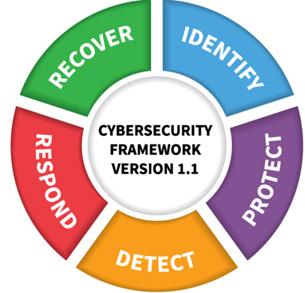
7 minute read
Cyber Resiliencey in 2020
Cyber Resiliency in 2020
By David Stafford-Gaffney
What does coronavirus and Cyber Resiliency have in common? Let’s explore this concept and see how it helps us with cyber resilience. As you are likely aware, the coronavirus is a major global concern for businesses and individuals. Like computer viruses, it is a threat that some recover from, while others fall mortally ill. There are processes being followed to manage the coronavirus threat, from prevention, detection and containment through to recovery: and it’s clear we are not yet out of the containment and response phases. So how does this global health emergency help us with cyber resiliency?
Resilience
The Oxford English Dictionary describes resilience as follows: Resilience: • the capacity to recover quickly from difficulties; toughness. • the ability of a substance or object to spring back into shape; elasticity.
Human Resilience: Something that differentiates some people from others is their level of biological resiliency. Infections will occur, however, some who contract coronavirus will recover, while others will fall seriously ill and even die. The likelihood of death increases for the most vulnerable groups; the elderly, those with respiratory issues, and the very young. Those who recover quickly are
14 | Australian Cyber Security Magazine considered more resilient, and they have specific attributes that afford them this prowess. They may be younger, have a good diet, are fit, are mentally active, and take dietary supplements to boost their immune systems. It might be that they are in tune to their body and detect subtle changes in state early enough so they can react quickly and cut out activity that is damaging and properly focus on recovery. The same patterns translate to systems.
System Resilience: Like people, organisations are susceptible to virus infections. And just like people, their systems may not recover quickly. System resiliency is key. If systems fail to recover in an appropriate period, organizational objectives can be impacted, so systems resilience is important to the organisation’s health. We now know some systems recover more quickly than others, making them more resilient. Factors that make systems more resilient include up to date antivirus systems, good patching, well controlled access management, network segmentation, and security monitoring. When we look at the elements that make people and systems resilient, they appear to fall into broad categories:
• Anti-Virus / Dietary Supplements – Protect • Monitoring / Detect subtle changes in the body early – Detect • Patching / Allow the body to recover – Recover

based difficulties.
With cyber the ability to recover is not just a test on the processes and mechanisms in place after threat detection, because the spread and impact of the virus will be determined by other controls, such as protective and recovery controls. Resilience is therefore a broad topic that extends through the lifecycle of threat management.
In information security we base our approach on a list of requirements derived from risk management, regulations, contractual obligations, applicable laws, government policy, and business strategy. Cybersecurity has, however, pivoted somewhat over recent years to focus more on resiliency rather than security management. This is largely the result of the assume you’re breached principle, which is attributed to several challenges organisations face: • Rapid pace of technology change • Transformation agendas, including cloud only, cloud first, etc. • Ever expanding ICT boarders for organisations • Skills gaps associated with transformation • Growing cybercrime industry estimated at over ~ $1 trillion • Increasing attack complexity
These challenges present opportunities for cyber events and incidents and although the focus is on resilience and therefore a quick recovery, it is important to understand that success in resilience is not just eradication. Whether it’s coronavirus, Swine Flu, or Wanncry, threats are always

Figure 1 - NIST Cybersecurity Framework - Nist.gov
present and protections from them will always be bypassed as they mutate and evolve. The question is, how do you achieve cyber resiliency?
The linkage back to cybersecurity is easily identified: to be cyber resilient, organisations need to ensure that they can recover quickly from cyber events and incidents. This is not a new focus for cybersecurity practitioners and doesn’t alter how they operate. What it does is change the priority of activities and initiatives implemented. While the concept of cyber resiliency is new, our existing management systems based on known standards like NIST Cybersecurity Framework (CSF) or ISO 27001, provide the perfect foundation for a cyber resiliency approach.
Let’s take NIST’s CSF and the its five domains (see Figure 1).
Figure 1 - NIST Cybersecurity Framework - Nist.gov If you look at the coronavirus analogy against NIST’s CSF, it follows a similar pattern to the management of computer viruses, especially. The pattern looks like this:
1. Identification was most likely the first phase. Understanding things that should be protected from a virus (people, organisations, countries, etc.) and the processes in place to manage the risks virus infection poses. 2. Deployment of protective controls would have taken place. Those might include, vaccinations, boarder controls, even the establishment of the World Health
Organisation. 3. Detective controls are used to in airports, hospitals and GP surgeries which bear the load in this phase. 4. The ability to respond to an infection or outbreak is next. In the case of the coronavirus, we have seen this escalate, especially in China, as the assessment revealed its lethality. Response efforts are then tested as other countries detect new cases of the virus. 5. How humans, governments, and cities recover from the virus is yet to be seen. This is because we are not out of the respond phase yet. The question remains as to what differentiates cyber resilient organisations from others? How do they achieve cyber resilience and what should be the board focus for organisations wanting to become more resilient?
If cyber resilience is about the capacity to recover from attacks, it is critical to focus on the security mechanisms that allow organisations to get back on their feet, through the stages of the NIST CSF. • Protective controls reduce the likelihood of an incident and reduce infections from spreading • Detective controls such as security event monitoring, help identify the threat when it first appears • Rapid response and containment activities reduce overall harm • Identification of critical assets helps focus recovery efforts where they matter
Managing your organisation’s environment using an Information Security Management system (ISMS) based on a known framework will improve your overall level of resilience. However, this will only work if you are diligent and implement controls across the entire framework and don’t focus only on the protective controls – which many organisations do.
Furthermore, not all organisations are equal and if you are facing the challenges mentioned before, or your current security posture isn’t where it should be, you fall into one of the high-risk, are vulnerable groups (like the elderly and very young facing the threat of coronavirus).
Even having a strong incident response plan and associated processes are not the only thing resilient organisations focus on. You most definitely need to have a good incident response plan, but you should also focus and prioritise the following:
1. Before any priority changes, you should assess your critical assets, since it’s they are what you are tasked with protecting. From there, you can review mitigating controls and understand your weaknesses or vulnerabilities. It sometimes helps organisation’s to commission an independent reviewer of business and cyber risks, as this approach is unbiased and removes local emotion and politics from the findings. 2. Have a rehearsed cyber incident response plan that includes a post incident evaluation process to assure continual improvement and shows you can respond to changing threats. Ensure this plan is communicated
Even having a strong incident
response plan and associated
processes are not the only thing
resilient organisations focus on.
You most definitely need to have
a good incident response plan
to all stakeholders to foster buy-in and prepare for possibly unwanted response actions, like the call to request a system shutdown at 3 AM. 3. Formally manage security, based on a reputable framework. Cover all control areas and ensure all stages of the identify, protect, detect, respond and recover lifecycle are designed, industrialised and tested. 4. Ensure you have a cyber aware executive team who understand the relationships between cyber and information security and are prepared to invest. Leave technical jargon and operational transactions at the door as this activity must influence and build trust with those who pay the bills. 5. Employees need to understand cyber hygiene. Whether developed in-house or as a service, you should invest in user awareness. Evidence shows phishing as the leading method hackers use to gain entry to their victim’s systems, and there is no better way to prevent this from being successful than to explain to users how to spot the attacks.
Transformation agendas, new technologies and the blurring of logical boundaries between IT and the business only introduce further vulnerabilities into our organisations. Just like the people who are resilient to coronavirus, simple protection is not enough, resiliency is also required. We must ensure our systems and organisations are both protected from threat and resilient once controls are bypassed. And the only way to do that is to approach it holistically, methodically, and with appropriate prioritisation.











